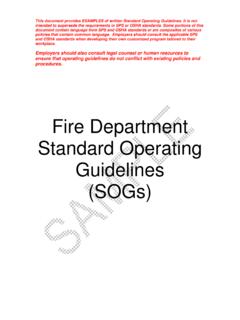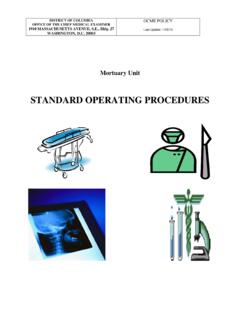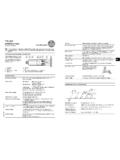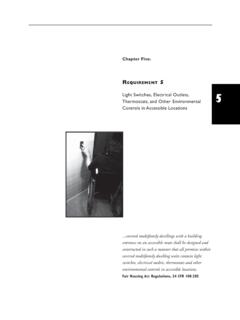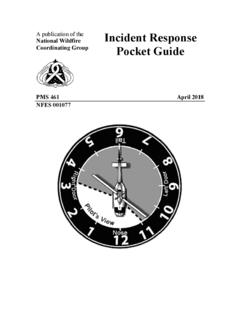Transcription of Chapter 10 Night Operations
1 Chapter 10. Night Operations Introduction The mechanical operation of an airplane at Night is no different than operating the same airplane during the day. The airplane does not know if it is being operated in the dark or bright sunlight. It performs and responds to control inputs by the pilot. The pilot, however, is affected by various aspects of Night Operations and must take them into consideration during Night flight Operations . Some are actual physical limitations affecting all pilots while others, such as equipment requirements, procedures, and emergency situations, must also be considered. According to Title 14 of the Code of Federal Regulations (14 CFR) part 1, Definitions and Abbreviations, Night is defined as the time between the end of evening civil twilight and the beginning of morning civil twilight. To explain further, morning civil twilight begins when the geometric center of the sun is 6 below the horizon and ends at sunrise.
2 Evening civil twilight begins at sunset and ends when the geometric center of the sun reaches 6 below the horizon. 10-1. For 14 CFR part 61 Operations , the term Night refers to 1 hour after sunset and ending 1 hour before sunrise as 14 CFR part Cones for Color 61 explains that between those hours no person may act as Detail Day pilot in command (PIC) of an aircraft carrying passengers unless within the preceding 90 days that person has made at least three takeoffs and three landings to a full stop during Rods for Gray that Night period. Peripheral Day and Night Night flying Operations should not be encouraged or attempted except by certificated pilots with knowledge of and experience in the topics discussed in this Chapter . Night Vision Generally, most pilots are poorly informed about Night vision. Human eyes never function as effectively at Night as the eyes of animals with nocturnal habits, but if humans learn how to use their eyes correctly and know their limitations, Night vision can be improved significantly.
3 Area of best day vision The brain and eyes act as a team for a person to see well;. both must be used effectively. Due to the physiology of the eye, limitations on sight are experienced in low light conditions, such as at Night . To see at Night , the eyes are used differently than during the day. Therefore, it is important to understand the eye's construction and how the eye is affected by darkness. Innumerable light-sensitive nerves called cones and rods are located at the back of the eye or retina, a layer upon which all images are focused. These nerves connect to the cells of the optic nerve, which transmits ion messages directly to the brain. The cones are located in the ght vis center of the retina, and the rods are concentrated in a ring s t ni f be ao around the cones. [Figure 10-1] Are Night blind spot The function of the cones is to detect color, details, and Are a of bes faraway objects. The rods function when something is seen t nig ht v out of the corner of the eye or peripheral vision.
4 They detect isio n objects, particularly those that are moving, but do not give detail or color only shades of gray. Both the cones and the rods are used for vision during daylight. Although there is not a clear-cut division of function, the rods Figure 10-1. Rods and cones. make Night vision possible. The rods and cones function in daylight and in moonlight, but in the absence of normal light, the process of Night vision is placed almost entirely on the rods. larger objects as the distance between the pilot and an object The rods are distributed in a band around the cones and do not increases. Use of a scanning procedure to permit off-center lie directly behind the pupils, which makes off-center viewing viewing of the object is more effective. Consciously practice (looking to one side of an object) important during Night flight. this scanning procedure to improve Night vision. During daylight, an object can be seen best by looking directly at it, but at Night there is a blind spot in the center of the field The eye's adaptation to darkness is another important aspect of vision, the Night blind spot.
5 If an object is in this area, it of Night vision. When a dark room is entered, it is difficult to may not be seen. The size of this blind spot increases as the see anything until the eyes become adjusted to the darkness. distance between the eye and the object increases as illustrated Almost everyone experiences this when entering a darkened in Figure 10-1. Therefore, the Night blind spot can hide movie theater. In this process, the pupils of the eyes first 10-2. enlarge to receive as much of the available light as possible. Close one eye when exposed to bright light to help After approximately 5 to 10 minutes, the cones become avoid the blinding effect. adjusted to the dim light and the eyes become approximately Do not wear sunglasses after sunset as this impairs 100 times more sensitive to the light than they were before the Night vision. dark room was entered. Much more time, about 30 minutes, is needed for the rods to become adjusted to darkness, but when Move the eyes more slowly than in daylight.
6 They do adjust, they are about 100,000 times more sensitive to Blink the eyes if they become blurred. light than they were in the lighted area. After the adaptation Concentrate on seeing objects. process is complete, much more can be seen, especially if scanning techniques are used correctly. Force the eyes to view off center using scanning techniques. After the eyes have adapted to the dark, the entire process Maintain good physical condition. is reversed when entering a lighted room. The eyes are first Avoid smoking, drinking, and using drugs that may dazzled by the brightness, but become completely adjusted be harmful. in a very few seconds, thereby losing their adaptation to the dark. Now, if the dark room is re-entered, the eyes again go Night Illusions through the long process of adapting to the darkness. In addition to Night vision limitations, Night illusions can Before and during Night flight, the adaptation process of cause confusion and distractions during Night flying.
7 The the eyes must be considered. First, adapt to the low level of following discussion covers some of the common situations light and then stay adapted. After the eyes are adapted to the that cause illusions associated with Night flying. darkness, avoid exposing them for more than one second to any bright white light as that causes temporary blindness. On a clear Night , distant stationary lights can be mistaken If exposed to a bright light source, such as search lights and for stars or other aircraft. Cloud layers or even the northern landing lights, remember that each eye adapts to the dark lights can confuse a pilot and indicate a false visual horizon. independently. By closing or covering one eye when exposed Certain geometrical patterns of ground lights, such as a to light, some Night vision acuity is retained in the closed eye. freeway, runway, approach, or even lights on a moving train, can cause confusion. Dark nights tend to eliminate Temporary blindness, caused by an unusually bright light, reference to a visual horizon.
8 As a result, pilots need to rely may result in illusions or after images until the eyes recover less on outside references at Night and more on flight and from the brightness. The brain creates these illusions navigation instruments. reported by the eyes. This results in misjudging or incorrectly identifying objects, such as mistaking slanted clouds for the Visual autokinesis can occur when staring at a single light horizon or populated areas for a landing field. Vertigo is source for several seconds on a dark Night . The result is that experienced as a feeling of dizziness and imbalance that can the light appears to be moving. The autokinesis effect will create or increase illusions. The illusions seem very real and not occur if the visual field is expanded through scanning pilots at every level of experience and skill can be affected. techniques. A good scanning procedure reduces the Recognizing that the brain and eyes can play tricks in this probability of vision becoming fixed on one source of light.
9 Manner is the best protection for flying at Night . Distractions and problems can result from a flickering light Good eyesight depends upon physical condition. Fatigue, in the flightdeck, anti-collision light, or other aircraft lights colds, vitamin deficiency, alcohol, stimulants, smoking, or and can cause flicker vertigo. If continuous, the possible medication can seriously impair vision. Keep these facts in physical reactions can be nausea, dizziness, grogginess, mind and take adequate precautions to safeguard Night vision. unconsciousness, headaches, or confusion. Try to eliminate In addition to the principles previously discussed, the following any light source causing blinking or flickering problems in items aid in increasing Night vision effectiveness. the flightdeck. Adapt the eyes to darkness prior to flight and keep A black-hole approach occurs when the landing is made them adapted. About 30 minutes is needed to adjust from over water or non-lighted terrain where the runway the eyes to maximum efficiency after exposure to a lights are the only source of light.
10 Without peripheral visual bright light. cues to help, orientation is difficult. The runway can seem If oxygen is available, use it during Night flying. Keep out of position (down-sloping or up-sloping) and in the in mind that a significant deterioration in Night vision worst case, results in landing short of the runway. If an can occur at cabin altitudes as low as 5,000 feet. 10-3. electronic glide slope or visual approach slope indicator the preflight visual inspection of the airplane, and the red (VASI) is available, it should be used. If navigation aids light is used when performing cockpit Operations . It is also (NAVAIDs) are unavailable, use the flight instruments to recommended to have a spare set of batteries for the flashlight assist in maintaining orientation and a normal approach. readily available. Anytime position in relation to the runway or altitude is in doubt, execute a go-around. Since the red light is non-glaring, it will not impair Night vision.












